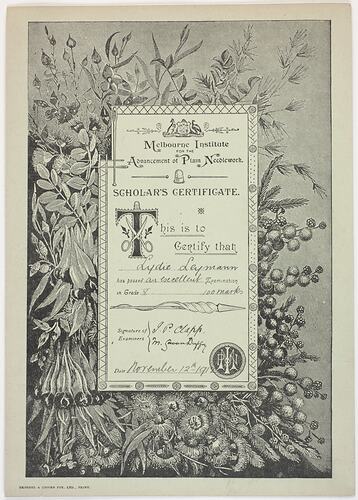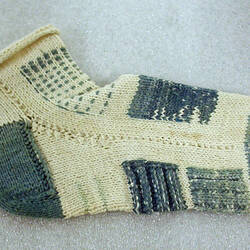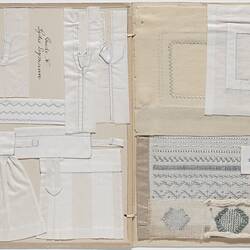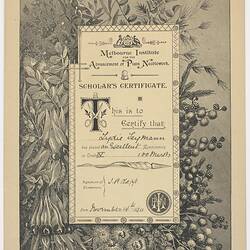Summary
Certificate issued by the Melbourne Institute for the Advancement of Plain Needlework to Lydie Leymann on 12 November 1912. It was presented for the completion of an 'excellent' examination in Grade V. It was printed by Troedel & Cooper, Ltd.
Lydie migrated to Australia form Switzerland in 1911, aged 14, to live with her aunt and uncle, Dr and Mrs Dunbar Hooper, in Toorak. She attended private lessons with Janet Mitchell, the youngest daughter of Lady Mitchell. The girls were taught by a governess at the Mitchell's home in Gipps Street, East Melbourne. They had normal school lessons in the morning, and then in the afternoon had lessons in sewing, piano, French and German. The sewing lessons, for which Lydie received this certificate, were examined by an external examiner under the auspices of the Melbourne Institute for the Advancement of Plain Needlework. Lydie described the lessons that she had as 'an Australian Finishing School'.
Lydie was born Lydie Leymann, in Switzerland circa 1897, and migrated to Melbourne in 1911 at the age of 14. She lived with her aunt and uncle, Dr and Mrs. Dunbar Hooper, in Toorak. Lydie was unable to return to Switzerland because of the outbreak of World War I, so remained in Australia and in 1920 changed her name by deed poll to become more closely identified with her uncle's family.
The family were well off and reguarly appeared in the social pages of Melbourne papers. Lydie's uncle was a well respected doctor and the son of Sir William Roe Hooper. Her aunt was Swiss and had come with Sir Henry and Lady Loch as governess to their daughters; she had met Hooper while he was medical adviser to the staff at Government House, Melbourne. The couple's wedding reception in 1888 was celebrated at Government House, with Sir Henry Lock giving the bride away at Christ Church, South Yarra, and amongst the distinguished guests was the Grand Duke Alexander of Russia.
Physical Description
Scholar's Certificate on green paper, with printed text and a background of an etching of wattle, Sturt's desert pea, flowering gum, gum leaves and other Australian flora.
More Information
-
Collecting Areas
-
Acquisition Information
Donation from Miss Lydie Hooper, 28 Nov 1988
-
Issued To
Miss Lydie Hooper, Toorak, Greater Melbourne, Victoria, Australia, 12 Nov 1912
-
Issued By
Melbourne Institute for the Advancement of Plain Needlework, Melbourne, Greater Melbourne, Victoria, Australia, 12 Nov 1912
-
Inscriptions
Text: Melbourne Institute / FOR THE / Advancement of Plain Needlework / SCHOLAR'S CERTIFICATE / This is to / certify that / Lydia Leymann / has passed an excellent examination / in Grade V, 100 Marks. / Signature of examiner: J.R.Clapp and M. Gavan Duffy / Date November 12th, 1912. [logo of Institute]. At top of certificate is a simplified version of the Australian coat of arms, with 'Advance Australia'.
-
Classification
-
Category
-
Discipline
-
Type of item
-
Overall Dimensions
31.5 cm (Length), 22 cm (Width)
-
Keywords
Domestic Life, Domestic Science, Education, Immigration, School Students' Work, Sewing, Swiss Immigration



